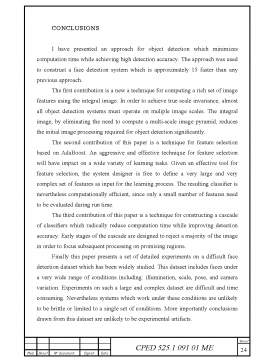Cuprins
- INTRODUCTION 3
- 1. INTRODUCTION TO VIOLA-JONES ALGORITHM 5
- 2. FEATURES 8
- 2.1. Integral image 9
- 2.2. Feature discussion 10
- 3. LEARNING CLASSIFICATION FUNCTIONS 11
- 3.1. Learning discussion 12
- 3.2. Learning results 12
- 4. THE ATTENTIONAL CASCADE 14
- 4.1. Training a cascade of classifiers 16
- 4.2. Detector cascade discussion 16
- 5. RESULTS 18
- 5.1. Speed of the final detector 19
- 5.2. Image processing 19
- 5.3. Scanning the detector 20
- 5.4. Integration of multiple detections 21
- 5.5. Experiments on real-world test set 21
- 5.6. A simple voting scheme to further improve results 22
- CONCLUSIONS 24
- REFERENCES 25
Extras din referat
INTRODUCTION
Computer vision is a diverse and relatively new field of study. In the early
days of computing, it was difficult to process even moderately large sets of image
data. It was not until the late 1970s that a more focused study of the field emerged.
Computer vision covers a wide range of topics which are often related to other
disciplines, and consequently there is no standard formulation of "the computer
vision problem". Moreover, there is no standard formulation of how computer
vision problems should be solved. Instead, there exists an abundance of methods
for solving various well-defined computer vision tasks, where the methods often
are very task specific and seldom can be generalised over a wide range of
applications. Many of the methods and applications are still in the state of basic
research, but more and more methods have found their way into commercial
products, where they often constitute a part of a larger system which can solve
complex tasks (e.g., in the area of medical images, or quality control and
measurements in industrial processes). In most practical computer vision
applications, the computers are pre-programmed to solve a particular task, but
methods based on learning are now becoming increasingly common.
The classical problem in computer vision, image processing, and machine
vision is that of determining whether or not the image data contains some specific
object, feature, or activity. This task can normally be solved robustly and without
effort by a human, but is still not satisfactorily solved in computer vision for the
general case: arbitrary objects in arbitrary situations. The existing methods for
dealing with this problem can at best solve it only for specific objects, such as
simple geometric objects (e.g., polyhedra), human faces, printed or hand-written
characters, or vehicles, and in specific situations, typically described in terms of
well-defined illumination, background, and pose of the object relative to the
camera.
Mod. Sheet document. Signat. Date
Sheet
CPED 525.1 091 01 ME 3
Face detection can be regarded as a specific case of object-class detection. In
object-class detection, the task is to find the locations and sizes of all objects in an
image that belong to a given class. Examples include upper torsos, pedestrians, and
cars.
Face detection can be regarded as a more general case of face localization. In
face localization, the task is to find the locations and sizes of a known number of
faces (usually one). In face detection, one does not have this additional
information.
Early face-detection algorithms focused on the detection of frontal human
faces, whereas newer algorithms attempt to solve the more general and difficult
problem of multi-view face detection. That is, the detection of faces that are either
rotated along the axis from the face to the observer (in-plane rotation), or rotated
along the vertical or left-right axis (out-of-plane rotation), or both. The newer
algorithms take into account variations in the image or video by factors such as
face appearance, lighting, and pose. The most popular algorithms are:
- Viola-Jones object detection framework - Viola & Jones
- Schneiderman & Kanade
- Rowley, Baluja & Kanade: Neural Network-based Face Detection
While detection rates are nearly the same, the speed of the Viola-Jones is roughly
15 times faster than the Rowley-Baluja-Kanade detector [12] and about 600 times
faster than the Schneiderman-Kanade detector [15].
Preview document
Conținut arhivă zip
- Rapid Object Detection Using a Boosted Cascade of Simple Features.pdf



























